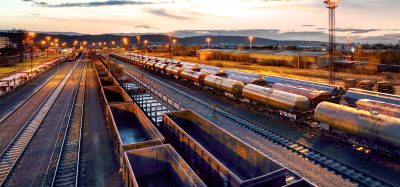Solutions for Stockholm’s rail bottleneck
Posted: 8 April 2008 | | No comments yet
Some three million people live and work in Stockholm and the surrounding region. It is a market place for trade with goods and services, a centre for culture and entertainment and a meeting place for people from all over the world. Many people also commute between work and their homes in the region, and the investments made in the railways around Lake Malar have served to make the train an attractive alternative to the car. The City Line is a precondition for the long-term development of rail traffic and for creating an attractive and efficient public transport system that meets the demands and requirements of the future.
Some three million people live and work in Stockholm and the surrounding region. It is a market place for trade with goods and services, a centre for culture and entertainment and a meeting place for people from all over the world. Many people also commute between work and their homes in the region, and the investments made in the railways around Lake Malar have served to make the train an attractive alternative to the car. The City Line is a precondition for the long-term development of rail traffic and for creating an attractive and efficient public transport system that meets the demands and requirements of the future.
Some three million people live and work in Stockholm and the surrounding region. It is a market place for trade with goods and services, a centre for culture and entertainment and a meeting place for people from all over the world. Many people also commute between work and their homes in the region, and the investments made in the railways around Lake Malar have served to make the train an attractive alternative to the car. The City Line is a precondition for the long-term development of rail traffic and for creating an attractive and efficient public transport system that meets the demands and requirements of the future.
Stockholm is built on many islands. Water surrounding the city on all sides gives it a great natural beauty, but causes difficulties for city centre communications. In rail traffic terms, Stockholm is waspwaisted. There are at present only two railway tracks running through Central Stockholm that have to be shared by all rail traffic – commuter trains, regional trains from the region, long-distance trains and freight trains – a situation which has existed since the railway first reached the city back in 1871. There is not much space – particularly in the rush-hour. Each day, these two tracks carry over 500 trains, approximately 60% of which are commuter trains. Eight out of every ten train journeys made in Sweden either begin or end in Stockholm.
Each day, a quarter of a million journeys are made by commuter train in Stockholm. Many people living in the northern and southern parts of the area use the commuter services to be able to travel quickly and easily to work, school and for leisure in Stockholm. At present, there is enormous pressure on the commuter train system – the carriages are often crowded and the trains do not always run on time. With the advent of the City Line, travel will be more convenient and reliable. The two new commuter train stations, Odenplan and City, will make it easier to change between commuter train, underground and bus services, which could help to cut travel times. The new centrally located stations also mean that commuter trains could prove to be an attractive alternative to the underground for those who live in Central Stockholm.
The City Line is a £1.3 billion rail-tunnel project, with two railway tracks running beneath Central Stockholm. The tunnel will extend from the commuter train station Stockholm South to Tomteboda, running in rock tunnels beneath Sodermalm, Riddarholmen, Norrmalm and Vasastan. Two completely new stations will be built – City Station and Odenplan Station. Work on the City Line will continue for approximately nine years. The City Line’s two new tracks will serve to double the capacity for rail traffic from the current 24 trains per hour in each direction to 48 – something that passengers both within and outside Stockholm will notice in the form of more frequent services, more punctual arrivals and departure times, plus shorter travel times.
The main part of the City Line will be in rock tunnels and the bedrock consists of younger granites and gneisses. From a construction point of view, the rock is very suitable and watertight along the main part of the tunnel. However, there are weak sections with extensive cracks predominately in the east-west direction. The geology above the rock surface has great variations. The most important is the esker in the north-south direction i.e. almost in the same direction as the tunnel. The esker consists of sand, gravel and cobbles and is also the only groundwater resource in the city. The esker permits good conditions for the foundation of the buildings and the areas on the esker are not sensitive for lowering of the groundwater. The strength of the rock is extremely durable, but takes its toll on the tunnelling machine, wearing cutters and is prone to racking up maintenance costs, which means that drilling and blasting is preferred instead of using a tunnel boring machine. As the work progresses, 25mm rock bolts between 2.4m and 7.0m long will be inserted in the walls to hold them stable and they will be protected from corrosion by an epoxy coating. The tunnel area varies between 25m2 (for single track), 110m2 (for double-track) and 220m2 (for stations). The area of the service and rescue tunnel is 40m2. A total of four million tons of blasted rock and 100,000 tons of soil will be excavated as 45,000 tons of dredged material. The only section of the tunnel to be built differently will be the underwater section in the south of the city, where the tunnel passes under the lake. The tunnel will be floated into position as an immersed tube. The length of this concrete tunnel will be 370m and the width 21m.
The City Line is being constructed with a view to the needs of the 2030s. The vision is that by that time, Sweden will be well on the way towards achieving an ecologically, socially, culturally and economically sustainable transport system. It will be easier to make day trips for business purposes between the major towns and cities, and by then the Swedish rail network will also be connected to the rail network serving the rest of Europe. Rail passenger transport will be so developed in terms of capacity and frequency of services that it will give people the chance to commute to and from work over an even greater area than at present. Furthermore, by 2030, effective rail connections and terminals for goods will have been created, which will improve the opportunities for transport on the railways. The City Line has an important role to play in this vision. It will allow full advantage to be made of the investments that have already been made in the region. The City Line is also a precondition for the investments that are being planned to improve rail traffic in Stockholm and the region and with the rest of the country, for example between Stockholm and Gothenburg and Stockholm and Malmö. All investments in improving the railway network – both already introduced as well as planned – will help to develop a transport system that is sustainable in the long-term and reduces the pressure on the environment.
Building a new rail tunnel in a city centre between 10 and 40 metres below the surface is a complex and high-risk undertaking. In fact, the project’s geotechnical models are the most complex ever run in Sweden. The new tunnel intersects the existing subway in two locations, so blasting necessitates the relocation of the subway track. WSP’s proposals included the preparation of a new prefabricated bridge concept to carry traffic during the construction period. The Swedish Rail Administration has, for some years, appointed WSP to carry out conceptual design and project management for the permanent way, water and waste-water installations for the entire length of the tunnel, as well as undertake rock geotechnical investigations and conceptual design for rock tunnels and concrete works. Recently, WSP won a huge contract. We are very proud to have been awarded one of the biggest and most prestigious projects in the history of WSP. Our multi disciplinary role includes preparing the tender documents and construction documents for the central parts of the City Line from Odenplan station to the southern dock of Riddarholmen; site supervision and project management of the Norrmalm tunnel and Norrstrom tunnel; and designs for the City station structure. This part of the project is worth in the region of £20 million.
WSP Civils Sweden is the principal civil engineering division of WSP Group plc, one of the largest engineering consultancies in Europe and among the ten largest in the world. In its 30 year history, WSP Group has been the lead engineering consultant on many landmark projects. London’s ‘Shard of Glass’, the Freedom Tower in New York City and the City Line in Stockholm are among several high-profile current projects. We are large for a simple reason: it enables us to offer clients several advantages. Large-scale means we have experts in many diverse disciplines. We can therefore offer services to cover every phase of a project, from early pre-studies, inquiries and planning, through to design, construction and management. In one organisation, we have engineers, landscape architects, planning architects, surveyors, geologists, urban planners and experts in many other disciplines. We can therefore form teams of people who have already successfully worked together many times before and achieved superb results. This saves time and money – efficiencies we pass on to clients, enabling them to achieve more for less. We not only have all this expertise in-house; we combine it with local knowledge through an extensive network of offices around the world. This allows us to manage diverse disciplines across different countries, cultures and industries. WSP has built up a vast range of knowledge and experience from having completed some of the most challenging engineering projects of recent years. We bring these insights to every project, ensuring all our clients benefit from the latest innovations and technical advances. We are ethical, so we take environmental concerns extremely seriously. We consider the impact of engineering projects on people’s lives and place great importance on improving quality of life through good design.
Eskil Sellgren
Eskil Sellgren is the Managing Director for WSP Civils Sweden, which is the main business area in WSP Sweden with more than 650 employees, mainly in the road and rail sector. Eskil Sellgren has received his MSc in Civil Engineering and PhD in Soil Mechanics from Chalmers University of Technology in Gothenburg.








